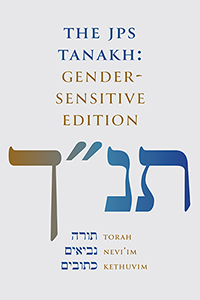וַיֹּ֙אמֶר֙ יְהֹוָ֣ה אֱלֹהִ֔ים לֹא־ט֛וֹב הֱי֥וֹת הָֽאָדָ֖ם לְבַדּ֑וֹ אֶֽעֱשֶׂה־לּ֥וֹ עֵ֖זֶר כְּנֶגְדּֽוֹ׃
The ETERNAL God said, “It is not good for the Human to be alone; I will make a fitting counterpart for him.”
(The above rendering comes from the RJPS translation, an adaptation of the NJPS translation. Before accounting for this rendering, I will analyze the plain sense of the Hebrew text.)
This noun’s usage colors the original relationship between the two sexes, and therefore it fell under the purview of the RJPS project. As Alter notes, however, this phrase is “notoriously difficult.” Rashi takes it narrowly, in sexual terms, as does Ramban: sexual differentiation will make easier the propagation of the species.
However, Alter’s point is well taken, in that the larger semantic range of the term is germane: “‘ezer elsewhere connotes active intervention on behalf of someone, especially in military contexts, as often in Psalms” (ad loc.). According to HALOT, there were two Hebrew roots ‘-z-r that gave rise to two homonymic nouns עֵזֶר, one of which has the sense of “strength, might.” Moses clearly renders praise when he repeatedly refers to God as an עֵזֶר who offers decisive assistance (Exod. 18:4, Deut. 33:7, 26, 29). This attribution suggests that the role is not necessarily a secondary one.
Moreover, the Tanakh in general depicts Israelite women as repeatedly and commendably displaying independent initiative, which suggests that such behavior was seen as normative—and thus would have been incorporated into this origin story about gender roles.
As for rendering into English, the NJPS ‘helper’ lacks the nuances of decisive aid or of independent initiative. Indeed, the label has a diminutive connotation—it’s nowadays applied mainly to young children (“Oh, you’re such a good helper!”) and to Santa’s elves. The NJPS choice is thus unfortunate and deserved to be replaced.
(Cf. NJPS, Fox, NRSV, TNIV: “helper”; Speiser: “aid”; Stern: “helpmate”; Korsak: “help”; Alter: “sustainer”; Mitchell: “partner”; Westermann “one corresponding to him”; Simkins “partner who corresponded to him”; Kimelman “counterpart.”)
The chosen rendering adopts the suggestion by Prof. Carol Meyers, when she served as the consulting editor for the CJPS rendering of Genesis, published in 2006.




